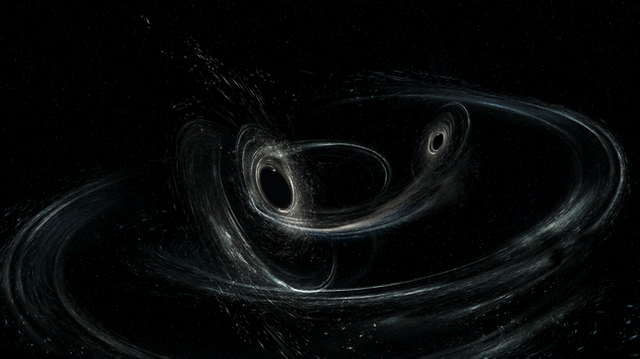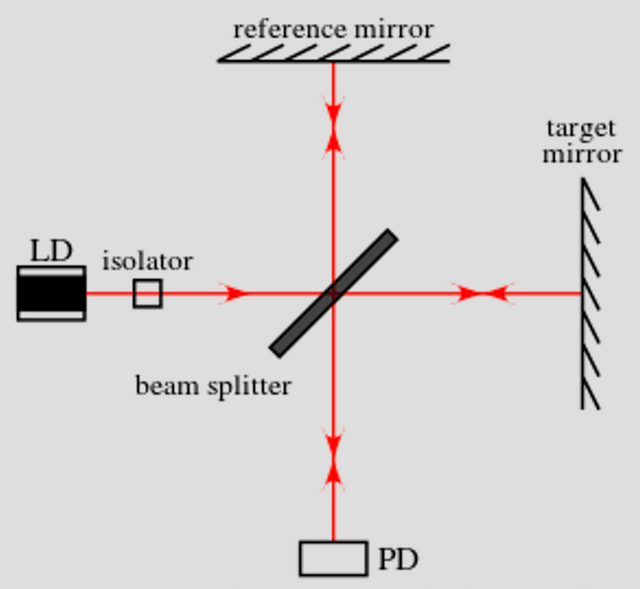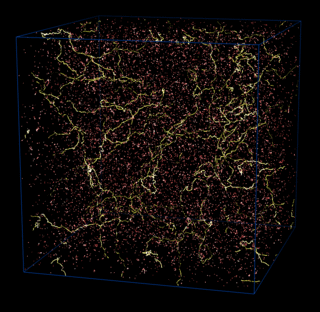Cosmic archeology with gravitational waves
It has been a while that I have not discussed gravitational waves. Triggered by a scientific article that I have read last week, here we go again! This article can be found here, and one may immediately notice the reason why it triggered my curiosity: it has an interesting title. We had by the way some fun about it on the steemSTEM chat as well.

[image credits: Wikipedia]
Cosmic archeology is just a fancy way to say that one targets the study of the early universe.
In the same way archeology addresses what was going on in the early days of the human race (and later too, but this is a kind of detail for this post), cosmic archeology focuses on what was going on in the early moments of the universe.
Nothing more, nothing less.
As archeology is a science associated with a dedicated set of tools allowing to dig into the old days of human history, cosmic archeology comes with a variety of tools allowing physicists to study what happened billions years go.
Gravitational waves consist of one of these tools.
I hope I didn’t say wrong things about archeology… I am sure that @zest will correct me heavily otherwise :p
GRAVITATIONAL WAVES IN A NUTSHELL

[image credits: Wikipedia]
Let us start with a definition. Gravitational waves are small ripples distorting spacetime that are generated by ‘catastrophic’ events in the universe.
In other words, once produced, gravitational waves slightly distort spacetime during their propagation, in the same way ripples can be observed when one throws a stone in water (as illustrated on the picture).
Gravitational waves consist of a prediction of the theory of general relativity proposed by Einstein in the first part of the 20th century.
They have been observed for the first time exactly 100 years later by the LIGO and VIRGO collaborations, and the observations were a sign of the merging of either two black holes or of two neutron stars.
And this detection yielded a Nobel prize some weeks ago :)
THE CHALLENGE: DETECTING GRAVITATIONAL WAVES
Let us now come back to one point.

[image credits: LIGO]
I have mentioned in the previous section that one needed catastrophic events in the universe to get some gravitational waves that are observables.
This stems from the fact that significant gravitational interactions are needed to get anything detectable on Earth.
In other words, we need events involving the gravitational interactions of super-massive objects like black holes or neutron stars to get something noticeable.
And even in this case, the ripples in spacetime that are generated are extremely small. When two huge black holes or neutron stars merge, one gets tiny variations of spacetime of about 10-19m.
This is is equal to. 0.0000000000000000001 meters, and this is the variation of spacetime that one needs to measure! The good news is that we managed to do it! Humans are sometimes suprizing, in particular when interferometry is used.
After a catastrophic event takes place in the universe, one needs to wait a little bit before being able to observe it here. The reason is that we need to give to the gravitational waves enough time to propagate.
Like electromagnetic radiation, gravitational waves travel at the speed of light. It will thus take some time between the moment the waves have been emitted and the moment they are recorded. Traveling in space indeed takes time…
DETECTING GRAVITATIONAL WAVES - THE BASICS
Gravitational wave detection relies to interferometry. One of the LIGO detectors (we have two of those, located in places separated by a couple of thousands of kilometers from each other) is shown in the picture below. In addition, we also have the European VIRGO detector that works in the same way.
Three is the magic number ^^

[image credits: LIGO]
A specific gravitational wave detector is made of two arms (as shown in the picture), in which a laser beam circulates in a system completely disconnected from the external world.
This allows one to avoid, or at least reduce the noise that would plague the measurements.
This external noise is also the reason why the detectors are located in very remote place, to get rid of any vibration that would originate from a too intense human activity.
As a result, the apparatus is shielded enough to be able to detect modifications of 0.0000000000000000001 meters, which matches the signal that would be expected from a gravitational wave.
In order to be sure that a record is not a local event, we need at least two detectors so that we could rely on coordination.
As gravitational waves travel at the speed of light, the signal associated with a real gravitational wave should be simultaneously recorded by all detectors (in contrast to the vibration issued from a truck passing close to one of the detectors).
DETECTING GRAVITATIONAL WAVES IN PRACTICE
In practice, the principle behind the detection of a gravitational wave is pretty easy. We can start with the picture below, where the red lines describe the path of the laser beam emitted by the laser source LD.

[image credits: Wikipedia]
The laser LD starts by hitting a beam splitter (the diagonal thick line in the middle of the picture) so that we get two beams issued from a single one. They circulate each in one arm of the detector (that has an ‘L’ shape).
One beam goes straight to the target mirror, and the other one is deviated to the reference mirror. The distance traveled by the beam is enforced to be identical.
When hitting the respective mirrors, the two beams are reflected and travel back to the splitter. The splitter however acts this time as a merger, and the merged beam is finally deviated to a detector PD.
If the two beams travel the same distance, the PD detector records a single dot (as when one would point a laser to a screen).
However, if the spacetime is distorted by a gravitational wave on the path of the beams, one of them would travel a larger distance than the other. We would consequently observe an interference pattern on the detector, i.e., a succession of bright and shaded areas.
From this, we can derive the initial distortion at an unprecedented precision, and actually measure variation of space time of 0.0000000000000000001 meters.
In the real life, the things are slightly more complicated, but the key principle is as sketched above.
REFERENCES AND DISCUSSION: COSMIC ARCHEOLOGY AGAIN
It is now time to go back to the topic. Gravitational waves issued from the merging of two black holes or two neutron stars have been recorded so far. But those are not the only events that are expected to generate waves.

[image credits: Cambridge]
Gravitational waves can actually be used as tools for testing the physics of the early universe.
In standard cosmology, many things that have happened during the very first moments of the life of the universe are expected to produce gravitational waves.
This includes, for instance, inflation and cosmic strings (to go back to the title of the paper which I have initially mentioned in this post).
In the cosmic string scenario, the universe is somehow populated by a network of strings, made of both long open strings and closed loops of strings. Those strings are extremely thin but they are very dense.
Therefore, they can be seen as a potential source of gravitational waves.
Thanks to the future gravitational wave experiments, physicists expect to get data to constrain these cosmic string scenarios through their capacity of producing gravitational waves. As a consequence. we could hence get more insight on the early times of the universe.
More information can be found here, as well as here and there for the gravitational wave detection articles. Plenty of information on LIGO is available here, and on VIRGO there.
For more discussion on this topic (or anything related to science), please join us on steemSTEM. SteemSTEM is a community driven project which seeks to promote well written/informative Science Technology Engineering and Mathematics postings on Steemit. More information can be found on the @steemstem blog.
My dear mentor and friend, I am truly honoured and humbled by you mentioning me in your article:)
You have encompassed the meaning of archaeology brilliantly:)
Thank you @lemouth!!!!
I was really hoping that you would like this post. Although I promised it last week, it took time as I am especially busy those days (guess what, I am flying in 7 hours :p).
Nice post @lemouth. Gravitational waves are quite a complicated topic and focusing on how they're measured was definitely a good call.
Thanks a lot for your message. Indeed, this is not an easy topic, but I am sure this will soon become generally known thanks to the Nobel prize and the recent observations :)
You finally brought this topic, "cosmic archeology". I was really wondering about it when you first mentioned it in the SteemSTEM chat.
I was thinking, cosmic archeology can be performed by looking at the farthest locations of the universe. The farther we go, the nearer we reach to the Big Bang.
And Gravitational Waves one of the most interesting topics of today's physics. The simplicity in which you mentioned the process of detecting gravitational waves is just amazing. Even a non-science student can understand it. 😄
I really feel proud to be in contact of amazing Scientists like you @Lemouth. :)
#SteemSTEM is amazing.
With gravitational waves, we are strictly speaking not looking far. We are waiting for what happened far to arrive here :)
Thanks a lot for your nice message! :)
I always had this particular question in mind, glad I read the answer here :)
You can also ask anytime any question. I will be glad to answer ^^
Does this Cosmic archaeology focus on what happened before the big bang or after the big bang?
I'm just trying to put two and two together.
After the big bang. There is actually no "before te big bang" as time is not defined before the big bang.
There is the theoy of a previous universe recollapsing into a singularity in a Big Crunch leading to the Big Bang observable in our universe, right?
But this is speculation and even then the possibility of observing information residues from this previous universe would be very questionable.
Actually, I don't see how to get any information from any previous universe at all :)
Wow!!👏 Although I made a post of which I mentioned gravitational waves recently, I still learnt a lot from this. I was only familiar with a few points:
Wonderful and highly qualitative content. I doff my hat for you, Sir @lemouth
Thanks for your comment ^^
The third item is however incorrect. Gravitational waves do not travel back in time. We in contrast detect gravitational waves that were emitted long ago (as they took so long to arrive on Earth). I guess this is what you meant :)
Yes..
This is kind of long to read it all, but I just wanted to say that when this post popped up, I was watching a movie called "Journey Back to Christmas". It is about the Christmas comet that appears every 71 years.
Aha! Interesting coincidence, although we are a bit far from the comet stuff here. I don't know the movie. What is it about?
Hey, looks as if we are colleagues? ;)
Kind of... As I said, just a matter of tools.
I could have actually added your name in the post, apologies about that.
I guess much in the same manner that it takes high energy events to create ocean waves (weather systems, quakes, asteroid impacts). Nature mimics that requirement in the cosmos.
It is however a different scale as the physics behind is different :)
awesome post
Thank you! :)